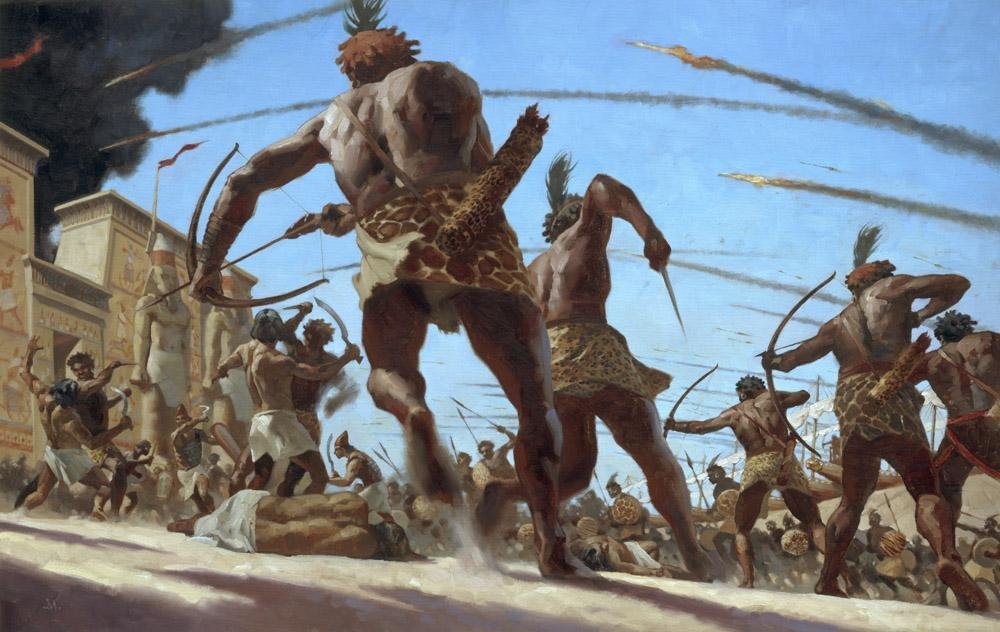PCs are two thief/specialists and a fighter. Being 5th level, they ride into town on horses. Immediately, like 2 real minutes into the game, the giant dragonfly back breaker flew up and killed two of the three PCs (second one jumped on to kill it when it grabbed first PC). So good and deadly random encounter charts.
Substantially same PCs (new ability scores, but same characters because they just got created) go into town. They go to Slippery Spot tavern hall run by a gangster lord type named Ferd. PCs accept his bounty to kill dragon fly, set out to do so. Get ambushed by pigmen, led by pigman chief, PCs kill him. Somehow (I forget) PCs lead more pigmen to near the dragonfly cave. In resulting fight, dragonfly kills pigmen while PCs attack. Everyone eventually runs away from the dragonfly, but PCs killed several pigmen.
Returning to village of Mlag, tavern keeper gangster dude Ferd and gang dudes try to kill PCs in their beds. PCs survive surprise, Oderus smashes his face in with his warhammer. They kill several of his guards. PCs find dude's sex dungeon in the basement, free the Old Lady who heals them. PCs fail to discover that Ferd was in league with the pigmen. They move to the other side of town and take up with Jack Dangle's much less creepy gan of skull heads (symbol no actual skulls).
They meet Dangle's homicidal demeanor end lieutenant Looper, who has scouted the Towers Two above town. After discussing things with Dangle, PCs decide to check out the towers run by the decadent noble brothers, Zal and Razak. After all the PCs were here because the king had promulgated an edict that the two Hane scions had gone too far and were now legally kill-able and could have their shit stolen. Razak and Zal have let their lands go to shit and have tumors of me romantic rituals and pigmen marauding, so it was pretty inevitable. Dangle secretly asks the PCs to make sure Looper disappears, and they kill him after he leads them to secret tunnel entrance in the woods.
Now underneath the towers, PCs find Zal's easterner jailor molesting some pigmen prisoners. They kill him, then try to set up a trap (setting fire to straw and sneak attacks) to kill some of Zal's gilded armored guards manning the entrances beneath Zal's tower. Plan fails although they kill a few guards. The Nameless, an assassin PC, and another thief PC are killed, while Oderus barely survives and is dragged as prisoner to Zal's throne room.
2 PCs roll up new characters; one is a cleric of deity of evil darkness and another is noble-born sorcerer Malort, second son. In the throne room of Zal, Malort and his companion, the darkness cleric, have an audience with Zal, able to get an introduction as Malort's family is of similar station to Zal. Oderus, wounded PC fighter, is dragged in by Zal's counsellor and father's old lieutenant, Cromwell (adventure says Cornwell but Cromwell was easier to say). Oderus is accused of being a spy for Razak, but Malort convinces them to spare Oderus and takes him into his service. PCs agree to undertake semi-suicide mission to blow up barrels of blasting powder beneath Razaks tower, Cromwell agrees to send a few guards with him. After being brought to his drug den behind the throne room, Malort feigns doing drugs with Zal and steals part of his stash and some gold and other stuff (reminder to self: check his character sheet). Oderus healed a bit.
Beneath the tower, PCs have Zal's handsome, cabana-boy-esque guards carry the blasting barrels. The PCs and guards get into a big fight with the pigmen at barricade in the tunnels beneath the two towers. The pigmen are overcome after Malort summons a demon into one of the corpses, a glass-demon in the shape of a giant salamander that distorts reality. They then advance to beneath Razaks tower (they may have pulled back and rested), where there are more pigmen by the door entrance. They blow a barrel and more mayhem ensues. While fighting the pigmen, Malort summons another demon, a pink shambling thing with claws and a sucker mouth, but this one fails to obey him. The pigmen behead Oderus and then the dark cleric tries to take them out with the other blasting powder, killing himself and a pigmen. Malort grabs Oderus's head and runs away as the remaining pigmen chase them.
After these two failed attempts, Malort decides to regroup at his house's castle. First, he hires a bodyguard and mercenary Rungus (new PC) who was drinking in Mlag at Ringler's joint. He travels home and has an audience with his father, Malort the Elder, and convinced him to risk sending 12 house soldiers and knights to take the towers for the family. Mallory (the other replacement PC), Malort's older knightly handsome brother (of middling intelligence and toughness, but strong), is convinced by Malort to accompany him to slay Razak and take his stuff. They also hire an experienced woodsman and tracking guide, Justin (new PC).
Next time, the taking of Razak...
















































